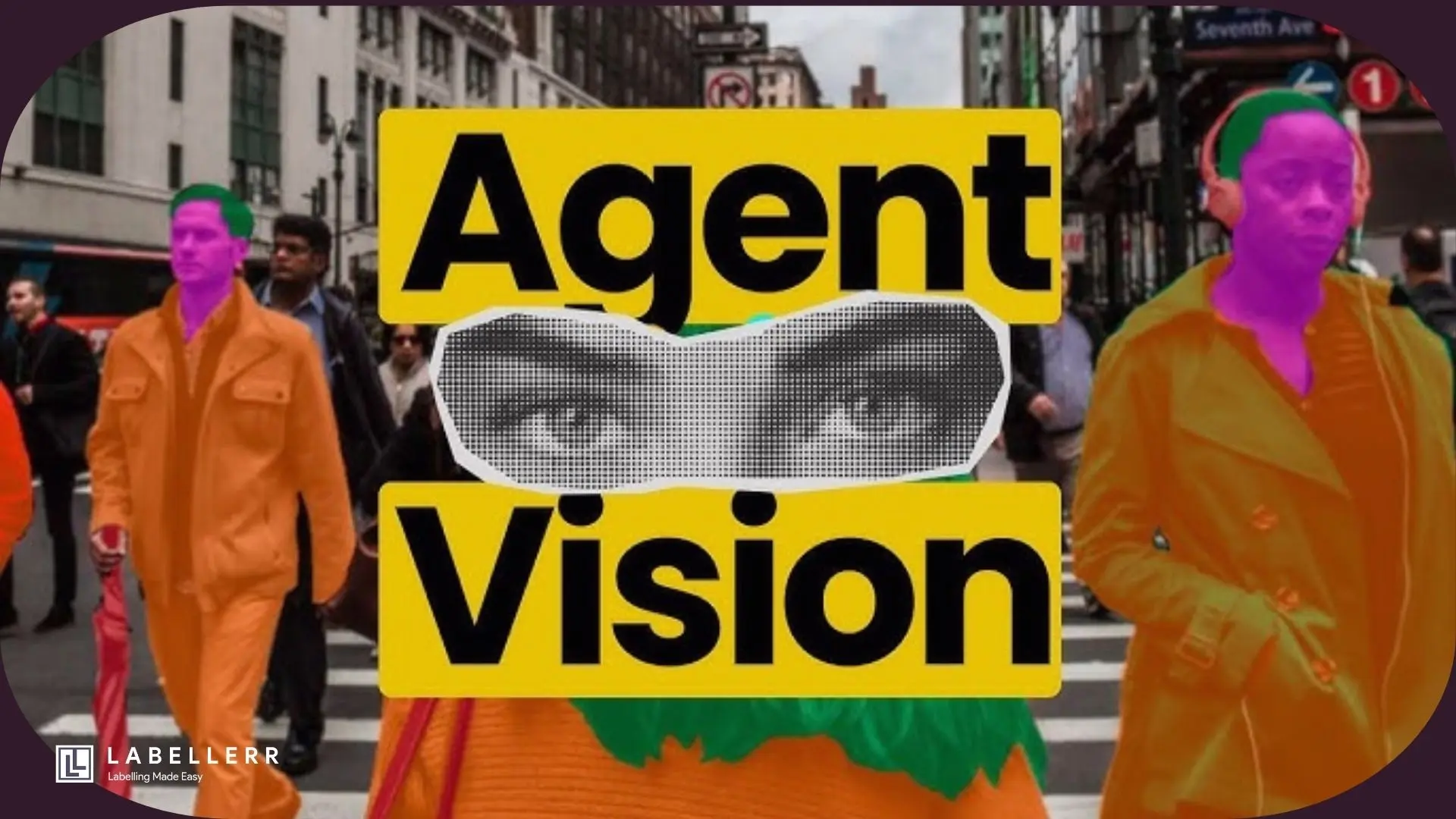Vision AI Agents: How They Work & Real-World Examples
Vision AI Agents bring machine perception to life, enabling AI to see, analyze, and react like humans. From surveillance to automation, these agents use computer vision and deep learning to interpret visual data in real time, transforming industries like security, healthcare, and robotics.

I spent weeks hunched over grainy surveillance footage, manually drawing boxes around cars and squinting to read license plates.
My team needed to track stolen vehicles, but labeling 10,000 images took forever. Just as we finished, a new batch arrived having 50,000 more frames with blurry plates, tilted angles, and rain-soaked cars. Traditional tools couldn’t help.
Rule-based systems I’d used for years failed if a plate was dirty, partially hidden, or had unusual fonts. Even OpenALPR struggled with low-light footage. If I wanted to add a new label, say, “commercial trucks” I had to rebuild the entire pipeline.
Then I tried Vision AI Agents.
A software that can scan 100,000 frames overnight, spot every license plate (even under mud or shadows), and extract digits with 95% accuracy.
Tools like IRIS and Landing AI Vision Agent do this. When the agent mislabels a “3” as an “8,” I fix it with a text prompt: “That’s a 3, not an 8, check the curved top.”
The agent learns instantly and updates all similar errors. For edge cases like handwritten plates, it generates synthetic data to fill gaps.
Suddenly, my surveillance workflow transformed:
- Detect: Cars, bikes, and plates in any lighting/angle.
- Extract: Letters/numbers from damaged or distorted plates.
- Act: Flag stolen vehicles in real time, not days later.
In this article, I’ll show how Vision AI Agents solve problems that once felt impossible and why sticking with old methods risks missing critical threats.
What Are Vision AI Agents?

Vision AI Agents are smart systems that see, understand, and act on visual data. They combine three core technologies:
- Vision Models: Detect objects (e.g., cars, license plates) in images/videos.
- Language Models: Process text commands (e.g., “Find all SUVs with dirty plates”).
- Action Engines: Automate tasks (e.g., extract plate numbers, flag suspicious vehicles).
Key Features
Autonomy:
- Learn from new scenarios without reprogramming.
- Example: A surveillance agent spots a car with a new license plate format and labels it automatically.
Multimodal Interaction:
- Process video feeds, text commands, and sensor data (e.g., motion detectors).
- Example: The agent scans live CCTV footage, reads a command like “Alert me for blue vans,” and triggers alarms in real-time.
Self-Healing:
- Fix errors using feedback.
- Example: If the agent misreads “A” as “4” on a plate, you correct it with “That’s ‘A’—update all similar errors.”
The Data Labeling Crisis: Why Traditional Computer Vision Fails

Traditional computer vision (CV) systems crumble under the demands of modern surveillance. Here’s why:
Problem 1: Scale
- Past: Older datasets like COCO (300k images, 3M labels) were manageable.
- Now: Models need 5B+ labeled images (e.g., FLD-5B) to handle real-world chaos.
- Example: A city’s CCTV network generates 1M+ frames daily. Labeling cars, plates, and pedestrians manually is impossible at this scale.
Problem 2: Rigid Pipelines
Traditional CV systems:
- Break if the footage is blurry, dark, or has new objects.
- Surveillance Failures:
- Miss license plates covered in mud or glare.
- Ignore new threats like delivery drones or disguised vehicles.
- Example: A rule-based system trained on cars fails to label electric scooters, leaving blind spots in traffic monitoring.
Problem 3: Cost
- Manual labeling costs $1−$10/image. For a city’s 10M surveillance frames: $10M-$100M.
- Small security firms can’t afford this, limiting innovation.
- Surveillance Impact: A police department abandons AI-powered plate recognition due to budget constraints.
Problem 4: Speed
- Labeling 1M images manually takes months, too slow for real-time crime prevention.
- Surveillance Nightmare: By the time you label footage of a stolen car, the vehicle is already dismantled.
How Vision AI Agents Fix This
- Scale: Tools like IRIS label 10,000+ frames/hour, even with rain, shadows, or motion blur.
- Adaptability: Learn new objects (e.g., drones) without restarting from scratch.
- Cost/Speed: Slash labeling costs by 90% and process data in hours, not months.
A traffic agency automates license plate extraction for 5M frames. Traditional CV fails on 30% of plates (blurry/angled). A Vision AI Agent fixes errors with prompts like “That’s a ‘P,’ not ‘R’” and cuts processing time from 6 months to 3 days.
How Vision AI Agents Work?
Vision AI Agents automate surveillance tasks by merging cutting-edge models into a seamless workflow. Here’s how they operate:
Core Components
1. Vision Encoders (YOLOv11, SAM2):
- YOLOv11: Detects objects (cars, bikes, license plates) in real-time video feeds. It splits frames into grids, predicts bounding boxes, and classifies objects at 100+ FPS.
- Example: Spots a speeding car in a 4K traffic feed, even at night.
- SAM (Segment Anything Model): Isolates specific regions (e.g., license plates) with pixel-level masks.
- Example: Segments a muddy license plate from a car’s bumper.
2. Language Models (GPT-4, LLaMA):
- GPT-4: Understands text commands like “Flag all black SUVs with out-of-state plates.”
- Example: It converts vague alerts (“Find suspicious vehicles”) into actionable tasks.
- LLaMA: Generates synthetic data prompts (e.g., “Create 100 images of obscured license plates”).
3. Action Policies (Reinforcement Learning):
- Workflow Engine: Triggers responses (e.g., alerts, database checks) based on detected objects.
- Examplereal-time: Extracts a plate number, checks it against a stolen vehicle database, and alerts police.
Real-World Tools in Action
1. Overeasy IRIS: Auto-Label 10,000 Images in 60 Seconds
Overeasy allows you to chain zero-shot vision models to create custom end-to-end pipelines for tasks like:
- 📦 Bounding Box Detection
- 🏷️ Classification
- 🖌️ Segmentation (Coming Soon!)
All of this can be achieved without needing to collect and annotate large training datasets.
Overeasy makes it simple to combine pre-trained zero-shot models to build powerful custom computer vision solutions.
How It Works:
1. Vision Encoders:
- SAM2 (Segment Anything Model): Creates pixel-perfect masks around objects (e.g., isolating license plates from car bumpers).
- CLIP: Matches image regions to text labels (e.g., links a blurry vehicle to “SUV” or “sedan”).
2. OCR Engine:
- PP-OCRv3: Extracts text from plates, even with distortions. Uses a CRNN (Convolutional Recurrent Neural Network) to read characters sequentially.
- Synthetic Data Generation:
- GANs (Generative Adversarial Networks): Creates fake but realistic images (e.g., plates under rain, snow, or glare) to fill data gaps.
3. Iterative Prompting:
- GPT-4 Integration: Lets users fix errors with commands like “Label all bikes as ‘two-wheelers’” or “That’s a ‘7,’ not a ‘T’.”
- CLIP Re-Embedding: Updates the model’s understanding without retraining from scratch.
2. Landing.ai’s VisionAgent: Industrial Defect Detection
VisionAgent, which is a generative Visual AI application builder that accelerates the development and deployment of vision-enabled applications.
VisionAgent acts as your Visual AI pilot when it comes to building vision-enabled applications.
Going beyond just code writing assistance, VisionAgent creates multiple plans when prompted with a vision task, selects the best-performing one and provides all the necessary code, tools and models for a deployment-ready solution.
Developers can iterate on vision tasks in minutes rather than weeks, getting to production faster.
How It Works:
1. Defect Detection:
- YOLOv8: Detects anomalies in real-time (e.g., cracks, dents) from 4K camera feeds.
- ResNet-50: Classifies defect severity (e.g., “critical” vs. “cosmetic”).
2. Multimodal Analysis:
- Thermal Imaging: Combines visual and heat data to spot hidden defects (e.g., overheating circuits).
- NLP Integration: Reads maintenance logs (e.g., “Check bearing X for wear”) to prioritize inspections.
3. Action Policies:
- Reinforcement Learning (RL): Decides whether to flag, halt production, or alert technicians.
Challenges & Limitations of Vision AI Agents
Data Privacy
Vision AI agents process sensitive information like license plates, faces, and medical scans. Protecting this data is a major challenge.
Encryption methods like Homomorphic Encryption allow secure processing but slow down AI models by 10 to 100 times.
Anonymization tools like BlurGAN can blur faces and plates in real-time, but they sometimes remove critical details.
For example, a city’s traffic camera system that leaks unencrypted license plate data could expose citizen movements, creating serious privacy risks.
Compute Costs
Training vision-language-action models is expensive, requiring high-performance GPUs. For instance, training YOLOv11 on 10 million surveillance frames costs over $50,000 using A100 GPUs for two weeks.
Fine-tuning GPT-4 for specific prompts like "flag abandoned bags" can exceed $100,000. These costs limit adoption, especially for small police departments, which struggle to afford real-time 4K video analysis for crime detection.
Bias in AI Models
AI models learn from data, and if that data is biased, the models will be too. A license plate recognition system trained mainly on English characters might struggle with Arabic or Devanagari plates, leading to misidentifications.
Some solutions include debiasing datasets, like FairFace, which adds diverse samples, and bias audits using tools like AI Fairness 360.
However, unchecked bias in surveillance AI could result in false accusations or unfair targeting of specific communities.
The Future of Vision AI Agents
Self-Improving Systems
Future AI agents will learn from their mistakes and improve automatically. Using active learning, systems like IRIS flag blurry license plates, request human verification, and retrain themselves overnight.
This approach, powered by Reinforcement Learning from Human Feedback (RLHF), helps AI adapt to real-world challenges without constant manual updates.
Edge Deployment
Running AI models on cameras, drones, and IoT devices instead of the cloud will reduce costs and response time.
For example, a dashcam with YOLOv11 Nano can detect stolen cars in real time without needing an internet connection.
This setup achieves 95% accuracy on 720p video and runs at 30 FPS on a $50 Raspberry Pi, making it a cost-effective solution for law enforcement and security teams.
AGI Pathways: The Next Step
AI is moving toward Vision-Language-Action (VLA) models, like GPT-4V and Google’s RT-2, which combine seeing, reasoning, and acting.
Imagine an AI agent watching a live surveillance feed, recognizing suspicious behavior (e.g., "That van has circled the block five times"), and alerting the police before a crime happens.
Real-time VLA models are becoming more practical with NVIDIA’s Jetson Orin, which enables on-device AI decision-making.
Conclusion
Vision AI Agents are transforming surveillance, making tasks like license plate recognition, vehicle tracking, and security monitoring faster and more accurate than ever.
These agents solve problems that traditional computer vision struggles with handling blurry images, adapting to new scenarios, and automating large-scale data processing.
With self-learning capabilities, edge deployment, and advancements in Vision-Language-Action (VLA) models, these systems are becoming more intelligent, efficient, and widely accessible.
However, challenges like data privacy, computational costs, and AI bias must be addressed before mass adoption.
FAQs
1. What are Vision AI Agents?
Vision AI Agents are intelligent systems that use computer vision and deep learning to analyze images and videos, enabling AI to interpret and respond to visual data.
2. How do Vision AI Agents work?
They process visual inputs using deep learning models, detecting objects, faces, and patterns to make decisions or trigger automated actions based on real-time analysis.
3. What industries benefit from Vision AI Agents?
Industries like healthcare, security, retail, robotics, and autonomous vehicles use Vision AI Agents for facial recognition, defect detection, automation, and smart surveillance.
4. Can Vision AI Agents replace human vision?
While they enhance efficiency, Vision AI Agents complement rather than replace human vision, excelling in speed, precision, and pattern recognition in structured tasks.
References

Simplify Your Data Annotation Workflow With Proven Strategies
.png)


